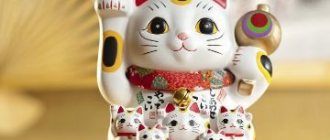Rare and exotic animals develop in conditions of geographic isolation. There are 2 subspecies of Japanese cat breeds. They are distinguished by the characteristic structure of their tail, or rather, its absence. In non-Asian countries, the breed is very rare and is distinguished by its high cost. However, for people suffering from allergies, they will become irreplaceable pets.
Features of Japanese breeds
Japan is a geographically isolated country with unique traditions and culture. Representatives of the cat breed are revered by the local population. However, religious beliefs influenced the development of new breeds. In the Asian country, the tail has long been considered a concentration of negative energy. Therefore, preference was given to animals with a genetic mutation that led to the loss of a tail.
Kittens with tails were subjected to a serious test. Because the Japanese, following cultural customs, cut off the demonic part of the animal. The isolated position of the country influenced the formation of its own variety of cats, called the Japanese Bobtail. Gradually, the fluffy creature gained great popularity not only in the Land of the Rising Sun, but also in other regions.
History of the breed
There is a legend that the ancestors of these animals arrived in Japan from China. Initially, cats had tails of a standard length, but a gene mutation played a role. Animals have been mentioned in national culture since the 16th century - they are depicted in many paintings. During this period, cats became the personal “toys” of emperors.
Japanese Bobtail
The year 1602 changed the status of the furry beauties - they were sent to war with rats. Mixing with ordinary street cats helped them become healthier and not degenerate like representatives of other breeds.
Important! The animals came to the USA with the American Elizabeth Freter, who was breeding Abyssinian cats.
What types are there?
Japanese exterior
The popular cat breed from Japan has gained recognition since 1976, when it was listed by the CFA. A couple of decades later, the world livestock breeding community recognized another species, which was called the longhaired bobtail. The Japanese kitten is represented by a characteristic exterior. The main requirements are:
- direct relationship with the bobtail;
- health;
- two-tone color (white, calico or white and tortoiseshell);
- taillessness.
Return to contents
Shorthair Japanese Bobtail
External features of the breed
Representatives of this species have average, harmonious body proportions. A notable feature is the “samurai stance”. On the muzzle, in the form of a regular triangle, there are round expressive eyes. Their color matches the overall coat color. The cat's ears are located vertically to the head and are set high.
The variety of wool colors is not so extensive and includes a couple of shades. Cats cannot be called fluffy, since there is no undercoat. This places them in the group of non-allergenic animals. Since Japanese women prefer to keep their apartment clean, they give preference to this breed. The tail is represented by a rudiment with thick, long hair.
Character traits
Experts have noticed that the Japanese cat is affectionate in nature, so it gets along well with children. They prefer active games with their owner and do not tolerate prolonged loneliness. Unlike other breeds, wool is moisture resistant. Therefore, the “Japanese” can swim in a bathtub or small bodies of water. The cat has a wide sound range, which ranges from meowing to bird trills.
What kind of health does he have?
The historical development of the Japanese cat breed has given its representatives excellent health. They are not susceptible to most diseases, since their genes contain immunity given by their ancestors. If there are disturbances in well-being, then with appropriate care, the cat will quickly recover. Kittens begin to walk and gain independence faster than other species. They have a long life of 15 years.
Longhaired Japanese Bobtail
External characteristics of cats
The breed looks a little different from the original prototype. Representatives invariably have a short, bushy tail that resembles a pompom. However, the hind limbs are longer than the forelimbs, so the gait is uneven. Large males do not exceed 4 kg in weight category. There is a depression between the nose and forehead. The ears are tilted forward and set wide apart. Unlike the short-haired breed, they have an undercoat. Molting occurs in the spring and lasts no more than a week.
Initially, the breed was called "bobby" and "chrysanthemum cat".
What kind of character does it show?
Felinologists note that the Japanese cat is hyperactive and playful. A distinctive feature is extremely developed jealousy. Therefore, the pet does not get along well in the company of pets. This can affect his psyche and lead to the formation of a bad character. With a gentle attitude, the animal will reciprocate and will treat its owners with tenderness.
Interesting facts about Japanese Bobtails
For centuries, Japanese bobtails lived on the streets of cities and villages. Thanks to this, they did not have closely related crossings, and also acquired immunity to many diseases. Because cats were outdoor cats, they have great intelligence and good survival skills. It is difficult for them to catch a cold, they are not susceptible to many infections and are able to eat a wide variety of foods.
Bobtails are very independent from an early age. For example, they can do much more than kittens of other breeds at the same age. Japanese bobtails open their eyes early, quickly learn to walk and run, and actively explore the world. They switch to adult food faster than regular kittens.
Bobtail tail length is a dominant gene, not a recessive one, so purebred cats will never produce a kitten with a long tail. As a counterbalance, you can put Sphynxes; sometimes hairless cats give birth to fluffy kittens, since the hairless cat gene is recessive.
The bobtail's short tail is a very sensitive area. Cats enjoy being stroked on the tail, but harsh touches can cause pain.
Japanese Bobtails are not afraid of water, and this is again influenced by the cats' outdoor origins. They willingly swim and climb into the bathtub on their own.
Most male Japanese Bobtails have mixed eyes, although these cats do not have other pathologies associated with different colored eyes.
Like hunting dogs, Japanese Bobtails love to play fetch. You can throw them a small toy or a small ball, and the cat will happily chase it and then bring it to the owner. This is what Japanese Bobtails say about their hunting genes.
Japanese bobtails are highly revered in Asia. Short-tailed cats are still considered a symbol of good luck, which is why many Japanese people get these cats.
Brief conclusions
Japanese cats are extremely popular in their homeland. However, outside its borders they are considered a rarity, and the price category is high. Thanks to their exotic appearance, friendliness and non-allergenic properties, more and more people are paying attention to them. With proper care and enough attention, representatives of these breeds will be very loyal and affectionate pets.
Today, almost every family has pets that bring joy to their owners. Cat breeds in Japan are not particularly diverse, but they will certainly surprise many with their cuteness. The absence of a large number of different breeds is explained by the fact that they are simply not selected, preferring everything natural and pristine. In our homeland, as well as throughout the world, people from the Land of the Rising Sun are not particularly popular, since they are not allowed to participate in international exhibitions. But they will certainly make a good choice as pets.
Appearance
The Japanese Bobtail cat comes in two types: long-haired and short-haired. It was only in 1968 that it received registration from the CFA Association.
Normal body weight in females is from 4 to 5 kg, in males – from 5 to 7 kg. The description of the standard contains the following points:
- head – should resemble a characteristic triangle with equal angles, the whisker pads are clearly visible;
- nose – longish, wide, the transition to the forehead is shallow;
- eyes - slightly obliquely spaced, regular oval shape, not protruding;
- ears - widely spaced, large, erect, with tassels at the tips;
- body – long body, lean and harmonious;
- paws – the front legs are shorter than the hind legs, the back does not bend forward;
- the tail is curled, reaches 7.6 cm when straightened, in the direction of the curl there are “chrysanthemums” (a regular ring) and “spirals” - with an open shape;
- The coat is long or short, with virtually no undercoat.
We suggest you familiarize yourself with: Sprouted grass for cats in a large pot
Important! Animals can have any shade of coat, but the standard does not include color point, chocolate, lilac, or ticked tabby.
Animals are deprived of the right to participate in exhibitions due to malformations of the tail:
- with sparse hair;
- does not resemble a pompom;
- completely absent.
Important! Individuals whose rounded part of the tail is moved away from the back by 2.5 cm are subject to disqualification.
Longhaired bobtail looks luxurious
Common Traits of Japanese Breeds
Let's look at this in more detail. Although there are several different types of cats in Japan, they all have certain characteristics that are common to all of them. If you look closely at a photo of a Japanese Bobtail cat or any other cat, you will notice some similarities between them. This is due to the fact that representatives of all breeds are distant relatives. In addition, the following features can be distinguished between them:
- The main breed is the bobtail, and others have been developed through crossbreeding.
- The roots of the breed go back to ancient times.
- All Japanese cats have excellent health.
- Lack of abundance of colors.
- Purely Japanese breeds always have the same eye color. If you find individuals with heterochromia, then these are the creations of American breeders.
- All cats lack a tail, which is their main distinguishing feature.
If you at least once see photos of Japanese cat breeds, you will never be able to confuse them with anyone else. And, as you probably guessed, the point here is not in appearance, but in the absence of a tail. But why don't animals have it? We'll talk about this later.
Japanese Bobtail - description of the breed
Japanese Bobtails are medium-sized cats. The weight of an adult cat is usually within four kg. In a calm state, the cat's tail points up, while in ordinary cats the tail always points down. The body is compact, muscular, well developed, but not squat.
The head of Japanese Bobtails is oblong, slightly angular, and has the shape of a triangle with curved lines. Sunken cheekbones are clearly visible. The nose is elongated, its boundaries are clearly visible. The cheeks are large, round and strong. The eyes are attentive, oval, and can be of any color. An open look gives the cat a curious appearance.
The paws are harmoniously developed, in good proportion to the body. The hind legs are slightly longer than the front legs, thanks to which bobtails balance well and jump high. The paws are oval in shape and the toe pads are always pink.
The ears of Japanese Bobtails have a wide set and are slightly tilted forward. This makes the appearance of bobtails focused and attentive. The coat of these cats can be both long and short. A distinctive feature is the silkiness of the coat, but there is no undercoat as such, which is typical for all Japanese cats.
Interesting fact: All Japanese Bobtails have a short tail. They get their name from the name of this type of tail – “bob”. It has a round shape and a length of no more than 3 cm.
Despite the shortened tail, Japanese Bobtails still have a caudal vertebra. This allows the short tail to move and allows cats to balance on small surfaces.
Reasons for the absence of a tail
Japan is an island nation, and its citizens' tastes are often misunderstood in other countries. This is a unique culture, strange traditions, various beliefs and much more. But why are tailless Japanese cat breeds so popular? It is impossible to answer this question, but we know how they appeared.
For a long time there was an opinion that animals had their tails cut off for a long time, and that subsequently they began to be born without it. However, such a version is unlikely. Scientists adhere to the theory that the main cause is genetic mutations. But they are not any disease or pathology, since animals, unlike many of their other brethren, have good health. Yes, cats do have a tail, but it is very small and more reminiscent of a hare’s.
Care
Shorthairs are easy to care for and are the most popular. Regular brushing removes dead hair and is highly welcomed by the cat, as it is part of communication with the owner.
In order for cats to tolerate such unpleasant procedures as bathing and trimming their claws more calmly, they need to be taught from a young age, the sooner the better.
Caring for long-haired dogs requires more attention and time, but is not fundamentally different from caring for short-haired bobtails.
Snoopy
Despite the fact that this breed is considered Japanese, however, it has nothing to do with this country. Its historical homeland and main habitat is China, but it turned out the way it did.
The Japanese Snoopy cat breed has a unique but pretty appearance. They have very funny faces and thick cheeks. The cats are shorthaired and have a rather exotic color called “red tabby van”. The breed appeared in the middle of the 20th century thanks to American breeders by crossing Persians and American Shorthairs.
Legends of the origin of Maneki-neko
There are many different legends about the origin of the symbol of a cat with a raised paw. All of them are stories related to Japanese history.
The priest's cat who saved a man's life
A Maneki-neko figurine with a fish in hand will help improve your financial situation.
A long time ago, a rich gentleman was traveling with a detachment of samurai on state business. He passed by the Gotoku-ji Temple, which at that time was experiencing financial difficulties. It was raining heavily. The master, or as it was commonly called in those days, daimyo, hid from the rain under a spreading tree. Suddenly he noticed a cat that belonged to the priest from the temple. The animal waved its paw, as if calling on the daimyo to follow it. The gentleman was very surprised - the gate was old and invisible in the dense thickets. If there had not been a four-legged savior, no one would have paid attention to the entrance to the temple. The daimyo came out from under the tree, walked a few steps, when suddenly lightning struck his shelter.
So the cat saved the life of a rich gentleman, who subsequently became friends with his owner and began to help the temple with generous donations. After the death of the cat, the daimyo ordered that a figurine be made in his honor. This is how the first Maneki-neko mascot appeared.
Courtesan cat
Black Maneki-neko will protect its owner from the evil eye and evil spirits.
In the early seventeenth century, brothels were popular in western Tokyo. At one of these high-class establishments there was a badass named Usugumo, who was incredibly fond of furry four-legged friends. There were always several pets next to her, but only one cat was the most beloved.
One day, Usugumo woke up late at night with the desire to relieve herself. She stood up, but suddenly her pet grabbed her kimono with her claws, hissed and tried not to let Usugumo go further than her room. The establishment's guard came running in response to the noise. He decided that the cat had gone mad and cut off its head. The head flew up to the ceiling from the impact and grabbed the snake that was hiding there with its teeth. So, after death, the cat saved its owner’s life.
Usugumo was very homesick for her pet. In order to dispel her sadness, one of the regular visitors gave her a figurine of a cat, which became the prototype of the Maneki-neko known today.
The story of the cat from Imado
Green maneki-neko helps strengthen concentration and memory.
One poor elderly woman from Imado, which is located in the eastern part of Tokyo, was left alone in her old age. She was forced to sell her pet cat to earn some money for food. But after a while the funds ran out, and the old woman found herself in a difficult situation.
One night she dreamed about her cat. He spoke to her: “Go make a figurine that looks like me and sell it to people.” The old woman obeyed and began making figurines from different materials. People liked her figurines, they were quickly sold out. In this way, the elderly woman was able to raise money and provide for herself for the remaining years. And the figures made by her hands acquired the halo of a talisman of good luck and prosperity, becoming the Maneki-neko amulet known to us.
Theory about the symbolic meaning of Maneki-neko
Some sources claim that the symbol appeared quite prosaically - a cat with a raised paw symbolized a courtesan luring her into cheerful neighborhoods. Theoretically, in ancient times, the authorities prohibited the use of a special symbol, and to circumvent this law, the courtesan houses came up with the Maneki-neko sign.
Characteristic signs
So what do you need to know about this? Representatives of this breed of Japanese cats are noticeably different from their other brothers. They are very friendly, calm and playful. Among the main characteristic external signs are the following:
- expressive brown eyes;
- small ears;
- chubby cheeks;
- very thick and soft wool;
- bushy tail.
But many breeders choose Snoopy not only for his attractiveness. These animals are phlegmatic, so they are very calm and not aggressive. In addition, they have excellent memory and well-developed intelligence.
Pros and cons of Japanese bobtails
The advantages of Japanese bobtails include the following aspects:
- These are cats with a memorable, unusual appearance. It's not just their tail that makes these cats stand out from others. They have an expressive muzzle and always an attentive, slightly wary look;
- Japanese Bobtails are loyal to their owners, so handing over an adult cat to other people is a wrong decision. The cat will really miss its previous owners.
- Bobtails are smart and have high intelligence. This allows you to train them and easily accustom them to the tray. Bobtails are sensitive to their owner’s mood and are ready to be near him at the right moment;
- Bobtails do not require careful grooming. For example, it won’t be difficult to bathe a Japanese bobtail – they are ready to get into the water themselves. The lack of undercoat makes them the least shedding cats.
The disadvantages of this breed include the following:
- The tail of Japanese bobtails really needs to be handled very carefully. Any sudden movement can cause pain and discomfort. Cats require very careful communication, so you should not touch the tail again;
- Japanese Bobtails are very active both as children and as adults. We need to buy them a lot of toys and scratching posts. Otherwise, carpets, walls and all furniture will come under attack. Also, these cats can play at night, which will prevent the owners from sleeping;
- Japanese bobtails are quite rare in the CIS countries and Europe. Kittens are extremely expensive, and finding a good nursery is difficult;
- Japanese Bobtails are stubborn. If they don’t immediately like the owner, then raising a kitten will be extremely difficult. He will do everything contrary to what the owner says;
- Bobtails are inquisitive, so they can accidentally run away from home and get lost. They also often put themselves in danger by jumping on hot surfaces or playing with sharp objects.
Bobtail
This breed is a subject of admiration and adoration not only among the Japanese, but also among people all over the world. In its homeland, it is considered rare and prestigious, and it is also believed that these pets bring good luck. The description of the Japanese Bobtail according to the standards is as follows:
- Slim and fit body of medium size;
- the head is shaped like a triangle with smooth curves;
- the muzzle is slightly elongated, with pronounced cheekbones;
- large and forward-leaning ears;
- oval-shaped eyes with different shades;
- long massive paws;
- short and soft wool;
- fluffy tail, the length of which can reach 15 centimeters.
If you look at the photo of the Japanese Bobtail, you will be convinced that this breed is incredibly beautiful. But appearance is not their only advantage. Animals are also distinguished by good health and unpretentiousness, so there are no special problems when caring for them.
History of the origin of Japanese bobtails
Japanese bobtails originate from East Asia. It is impossible to say with certainty when exactly this cat was born, since evidence of their existence dates back to 500 BC.
Interesting fact: Japanese bobtails came to the Asian islands through merchant ships that carried numerous cargoes. The Japanese especially liked cats - representatives of this nation have always treated cats well. At that time, Japanese cats still had tails, although they already had distinctive features.
Emperor Ichijo was the first to domesticate cats in Asia, although this is only the official version. Fear of the demonic essence of cats prevailed among the population, so residents preferred to avoid them. The first imperial cat, Myob-no-Otodo, was respected among the palace servants and had many privileges.
Soon a legend appeared about a dark cat who watches people and notes which people behave indecently. The cat sent troubles to such people through other cats. People believed that the evil energy of cats was contained in their tails, so they began to chop them off. A cat with a severed tail received the status of lucky and happy - such animals were willingly kept at home.
Thus, physical abuse of cats gave birth to an entire breed. Kittens began to be born tailless or with crooked tails, and superstitious residents considered this a good sign. Tailless cats were actively crossed with each other, producing new unusual kittens.
Several tailless kittens were purchased by American traders around 1968. From there they were transported to western Asia, and then to Europe. In Europe, a breed standard was created, which was called the Japanese Bobtail. This breed was officially recognized in 1976 by the International Cat Federation.
Character traits
What should you pay attention to first? Japanese Bobtail cats are not like their Snoopy cousins. They are hunters by nature, so their character is simply explosive. Animals catch everything that moves, so a private house is best suited for keeping them. In a city apartment, cats will not have enough physical activity, which will negatively affect their health and behavior.
Another key point to keep in mind when owning bobtails is that they quickly learn bad habits. Therefore, upbringing needs to be done from the very first days, otherwise it will be quite difficult to retrain the cat. As for character, the animals are very friendly not only to adults and children, but also to other four-legged inhabitants. But owners will have to devote a lot of time to their pet, since bobtails are incredibly loyal and need constant communication.
Character and habits of Japanese Bobtails
Japanese bobtails have an interesting character. They become attached to their owners and love to spend time with them. For example, they like to watch their owner cook or they like to sleep next to their human. Bobtails become attached to the whole family and get along well with small children, even patiently enduring their fur being pulled.
But Japanese Bobtails are quite talkative and noisy cats. They meow a lot, willingly entering into dialogue with people. Although their meow is quite quiet and subtle, so it is not always audible, which is why the cat looks a little timid.
Bobtails are playful and active from an early age. Since this is a very ancient breed of cats, their instincts are well developed - these cats were previously bred by people to hunt rodents and pests. At home, where there is no one to hunt, bobtails find their own prey, so there is a high probability that the kitten will tear up the furniture and wallpaper. They love to carry toys and many other objects in their teeth.
Interesting fact: Thanks to their high intelligence, bobtails are easy to train - the main thing is to turn the learning process into a game. For example, bobtails can fetch objects and perform simple tricks.
Japanese Bobtails are sociable and friendly animals. They can be kept with other cats and dogs, or even better, with the same breed. They gather in small flocks, sleep and play together. When several bobtails gather in the house, they will definitely not be bored.
But you must understand that Japanese bobtails will not tolerate bad treatment. You can’t beat cats or raise your voice at them – they remember this. Japanese bobtails will not take revenge on their owners, but they will refuse to follow commands and ignore people quite well.
Features of care
This aspect deserves special attention. As noted earlier, the Japanese Bobtail breed is unpretentious and clean. Thanks to their short fur, the animals do not shed and do not need to be brushed frequently. You also don’t have to bathe too often; once or twice a year will be enough.
But the ears should be given more attention. They need to be cleaned every week, because due to their large size, a considerable amount of dirt accumulates in them. In addition, nails should be trimmed regularly. They grow back quickly, so if they are not put in order in time, the animals will experience pain when walking.
Caring for Japanese Bobtails
Japanese Bobtails are easy to care for. They are clean, lick their fur independently and always use a litter tray. A minimum of effort is required from the owners.
Bobtails do not often need to be brushed because they have almost no undercoat. The fur does not roll into clumps, and shedding is almost unnoticeable. Once a week you should brush them with a soft natural bristle brush to remove excess fluff, otherwise your pet will accidentally eat it. During the shedding process, cats should be brushed every day.
Important fact: Cats do not need to be washed often, although Japanese Bobtails love to bathe. Water dries out their skin, so too frequent water procedures are fraught with skin diseases.
Once a week, the ears should be examined and external ear discharge should be removed. You shouldn't go into a cat's ear. Eyes should be wiped every day with a cotton pad soaked in warm water. For claws, it is better to purchase scratching posts, since Japanese bobtails sharpen them on their own, and, as a rule, there is no need to cut off the claws.
In addition, Japanese Bobtails love walks. For walks, you need to purchase a special leash that will not restrict your pet’s movements. It is worth remembering that bobtails are, first of all, an outdoor cat breed that loves movement and hunting. Do not let your pet off the leash, otherwise he may chase the first prey. But let him sometimes climb trees and lie in the grass - they love it very much.
What to feed
So what do you need to know about this? Experts say that the diet of Japanese Bobtail cats should be of high quality and balanced. Therefore, it is better to feed not homemade food, but premium purchased dry food. If you want to start planning the menu yourself, then you need to take into account the fact that cats are carnivorous animals, so meat must be present in their life. But plant foods, which are a source of vitamins, minerals and carbohydrates, are no less important.
When feeding homemade food, it is necessary to add vitamin complexes to it. But it’s still better to stick to dry food, since they are perfectly balanced, contain all the nutrients necessary for normal growth and good health, and will also cost less than buying food in a store.
Care and maintenance
Caring for a Japanese cat is easy and pleasant. They are clean, take care of their fur, constantly lick and wash themselves. They love to be scratched; long-haired dogs have their fur combed twice a week; short-haired dogs can be brushed less often, but always during shedding. Organize a resting place, preferably a multi-level play complex with a bed or a house. Definitely with a scratching post.
Place the litter tray in a secluded place and keep it clean; the pet will not use a dirty toilet. You can put two side by side for convenience.
There is no need to bathe your bobtail, but you need to keep your eyes and ears clean regularly. The claws are trimmed as they grow with a special nail clipper.
Important! If purulent discharge appears from the eyes and ears, immediately consult a veterinarian and follow all his instructions.
Diet
The feeding diet of Japanese bobtails can be of two types:
- Ready-made factory food in dry or canned form is very convenient for busy owners and healthy for the pet. Manufacturers produce ready-made food that is balanced in nutrition and vitamins. In the line of feeds, only super-premium class and higher include a composition taking into account the age of the animal and its physiological state.
- Natural, homemade food is no less useful for the pet, but more troublesome for the owners. It is necessary to prepare a certain composition of products, process and prepare them taking into account maintaining a balance in nutritional value and the composition of vitamins and minerals.
The ratio of products is maintained in approximately the following proportions:
- meat and offal at least 40%
- fermented milk products up to 30%,
- porridge with water 20%,
- vegetables and herbs 10%
- Be sure to include a vitamin complex
The daily amount of food for an adult cat is calculated based on the pet's body weight and should be approximately 50 g per kilogram of weight. This takes into account not only the weight of the animal, its health and physiological condition. To avoid overfeeding, the norm is 80 kcal per 1 kg of body weight.
Important! And with natural, and especially dry ready-made food, the animal should always have a large bowl of clean bottled water near the food.
Health and diseases
Japanese bobtails have stable immunity to various diseases, and timely vaccination with a full range of vaccinations makes them absolutely healthy. The short tail was formed through the process of genetic mutation and does not cause diseases of the musculoskeletal system. If the nutritional balance is not maintained and the amount of vitamins and minerals is insufficient, the pet may experience severe hair loss and constipation.
Important! In addition to annual vaccination, the pet is treated with antihelminthic drugs, and the fur is treated with sprays against fleas, ticks and other parasites. Be sure to wear a collar treated with a repellent compound.
Breeding
Bobtail and Snoopy cats are ready for mating at the age of one year. However, breeding them is a rather problematic activity. The thing is that these animals are not very common in our country, so finding a suitable partner for a cat in order to get purebred pedigreed kittens is not an easy task. During the search process, you need to consider the following nuances:
- presence of pedigree;
- the length of the tail should not exceed 8 centimeters;
- healthy appearance;
- activity in behavior;
- colors.
If you manage to find a suitable cat that meets all the criteria, then there will be no problems with breeding. Due to their good health, animals give birth on their own without the help of their owner. Mating is possible up to two times a year, and in one litter there can be from 2 to 7 kittens. Cats are very devoted parents, so they do not leave their children a single step, and also provide them with proper care and constant protection.
Diseases and health problems
Japanese Bobtails are a native breed that lived exclusively in East Asia. These cats have a long history, most of which they lived outdoors and were almost wild animals. Thanks to various crossings and staying within the same territory, Japanese bobtails have acquired surprisingly good health and strong immunity. These cats actually do not have any genetic diseases.
A short tail does not in any way affect the abilities of these cats or their well-being. The only caveat is that the tail is very sensitive, so you should not touch it sharply, hit the tail or irritate it in any way. However, a short tail does not cause spinal curvature or prevent cats from balancing on unstable surfaces.
Japanese bobtails hardly get cold outside, they can eat junk food and not get poisoned (it’s not worth taking risks with this aspect). They also tolerate pregnancy well and give birth easily. They are not susceptible to many infectious and colds.
There are a number of external defects that do not affect the cat’s health in any way, but exclude it from the Japanese Bobtail standard:
- Excessively developed muscles, earthiness, stocky physique;
- Head too rounded;
- Complete absence of a tail, in which there are no caudal vertebrae at all;
- The tail does not look like a pompom and is not fluffy enough;
- A tail over thirteen cm is also not considered by this breed;
- If the tail bends in any way, this is also a deviation from the breed standard.
A very rare breed of Asian cats
The most interesting thing is that the Japanese themselves have long known that on their mountainous island of Iriomote-jima, 90% covered with virgin subtropical forests, and 10% of the “land” is mangrove swamps, not only 2000 people live, but also strange striped cats. They knew, but did not attach much importance to this, considering striped kitties to be feral descendants of an ordinary domestic cat, which “got in touch” with a Bengal cat in an unkind hour. The Japanese didn’t even know that this was a completely separate species of the genus Prionailurus (Asian cats), and when they found out, they didn’t believe it.
When the Japanese doctor of zoology, scientist of the National Science Museum of Tokyo, Professor Yui Imaitsumi, announced his discovery in 1965, he was almost laughed at, assuring him that such large animals, which the civilized world does not yet know about, no longer exist in nature .
How wrong they were all!
Every 10 years, biologists discover more than 100,000 new species of insects, plants and animals based on genetic and morphological data. And it doesn’t have to be a bug or a blade of grass! For example, 5 years ago, elephants on the island of Borneo were recognized as a separate species of Elephantidae after DNA analysis.











